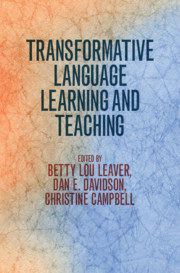Book contents
- Transformative Language Learning and Teaching
- Transformative Language Learning and Teaching
- Copyright page
- Contents
- Figures
- Tables
- Contributors
- Foreword
- Acknowledgments
- Abbreviations
- 1 Introduction
- Part I Theoretical Framework
- Part II Transformative Language Learning and Teaching Applications in Government Programs
- 5 Open Architecture Curricular Design
- 6 Foreign Language Learning Efficiency
- 7 The Challenges of Implementing Transformative Pedagogy
- Part III Transformative Language Learning and Teaching Applications in University Programs
- Part IV Transformative Language Learning and Teaching Applications in Immersion Programs
- Part V The Learner
- Part VI Faculty Development
- Part VII Assessment
- References
- Index
5 - Open Architecture Curricular Design
A Fundamental Principle of Transformative Language Learning and Teaching
from Part II - Transformative Language Learning and Teaching Applications in Government Programs
Published online by Cambridge University Press: 26 January 2021
- Transformative Language Learning and Teaching
- Transformative Language Learning and Teaching
- Copyright page
- Contents
- Figures
- Tables
- Contributors
- Foreword
- Acknowledgments
- Abbreviations
- 1 Introduction
- Part I Theoretical Framework
- Part II Transformative Language Learning and Teaching Applications in Government Programs
- 5 Open Architecture Curricular Design
- 6 Foreign Language Learning Efficiency
- 7 The Challenges of Implementing Transformative Pedagogy
- Part III Transformative Language Learning and Teaching Applications in University Programs
- Part IV Transformative Language Learning and Teaching Applications in Immersion Programs
- Part V The Learner
- Part VI Faculty Development
- Part VII Assessment
- References
- Index
Summary
The term, open architecture, originates in the information technology world, where open architecture is designed to make adding, upgrading and swapping components easy. Open Architecture Curricular Design (OACD) in language learning promotes continual change of activities and tasks according to learner needs, specifically their styles, strategies, level of fossilization, interests, and zone of proximal development. At early levels, a textbook is frequently (though not always) used to ensure all learners are exposed to the same content corpus, with focus on structure and lexicon. The OACD teacher creates flexible lesson plans according to a thematically-based syllabus based on authentic materials. The teacher, who takes on the role of advisor, mentor, and partner, negotiates aspects of the syllabus and lesson plans with the learners, using formative, educative assessments to achieve the ultimate goal-to transform learners into bicultural people.
Keywords
- Type
- Chapter
- Information
- Transformative Language Learning and Teaching , pp. 43 - 50Publisher: Cambridge University PressPrint publication year: 2021



